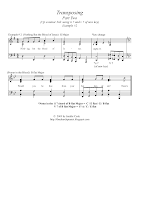Transposing is such a large topic to cover!
Transposing tips for today's example #2:
Notice how closely related the chords are
during the transposition; allowing for a smoother
harmonic transition.
For example:
Look at the measure marked
"key change". The first chord in the right
hand maintained the previous chord's top
note; only altering the bottom two notes.
A slight ritard during the key change prevents
a rushed transition.
Try transposing on your own. For easier practice,
choose two hymns with similar moods and time signatures.
*Link to the first example for Transposing (Part Two)*
Please feel free to ask questions or leave comments.
Thanks again for visiting!
My new website: http://thechurchpianist.com/



2 comments:
Can I ask a question? I'm not too great on theory (which I shold be), but what is the ii7 chord? This kind of transposing I'm not familiar with but would like to learn how to do it. Thank you!
The number: ii represents the second note in whatever key you're in.
For example, in the key of C...the note 'D' would be the second note.
Well...a triad (3 note chord) can be built on each note of a scale.
The ii chord in the key of C is...DFA.
Next...
The number '7' means the 7th note from the bottom of the ii chord.
The note 'C' is a 7th above 'D'.
So...the ii 7 chord in the key of C would be: DFAC.
Hope this makes sense. I used the key of C Major for easier application.
Maybe I should do an article on this topic. I will feel that one out. Thanks for asking!
Post a Comment